1998 PONTIAC BONNEVILLE spare tire
[x] Cancel search: spare tirePage 249 of 395
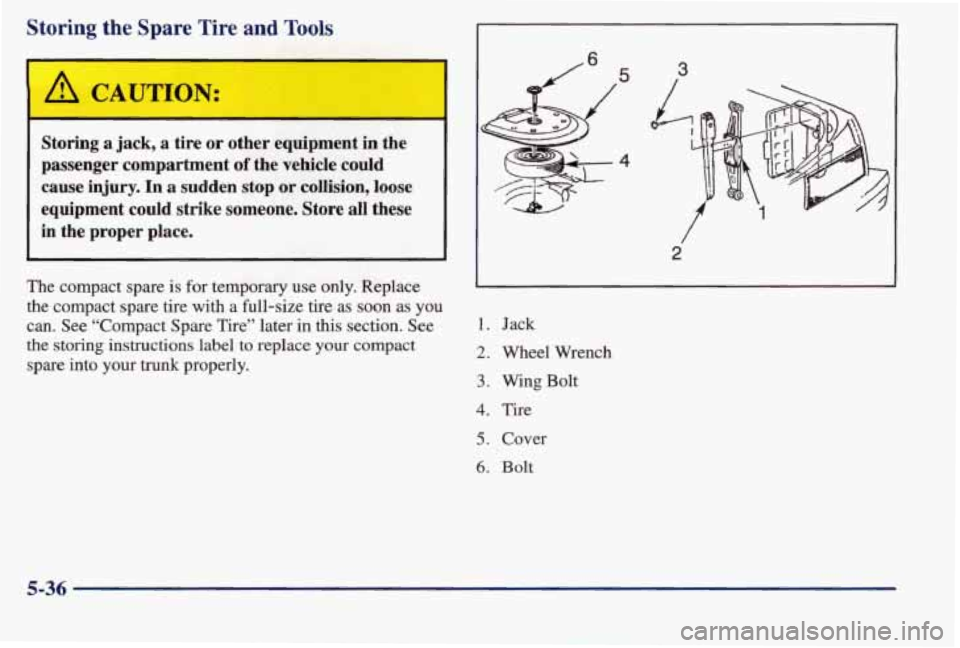
Storing the Spar1 rire and Tools
I A CAUTION:
Storing a jack, a tire or other equipment in the
passenger compartment
of the vehicle could
cause injury. In a sudden stop or collision, loose
equipment could strike someone.
Store all these
in the proper place.
The compact spare is for temporary use only. Replace
the compact spare tire with a full-size tire as soon
as you
can. See “Compact Spare Tire” later in
this section. See
the storing instructions label
to replace your compact
spare into
your trunk properly.
5 3
4
2
1. Jack
2. Wheel Wrench
3. Wing Bolt
4. Tire
5. Cover
6. Bolt
5-36
Page 250 of 395
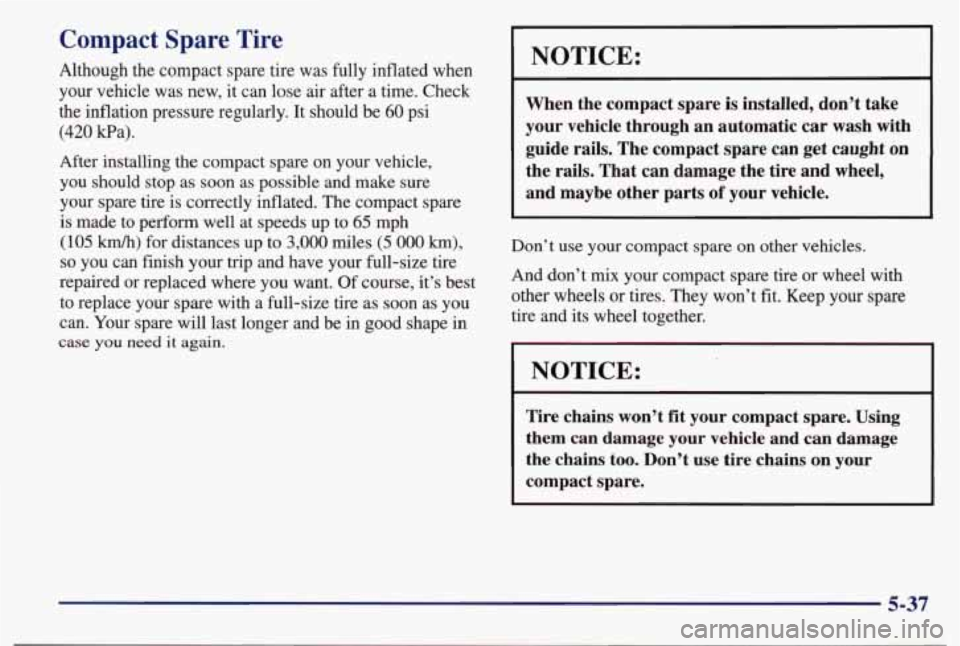
Compact Spare Tire
Although the compact spare tire was fully inflated when
your vehicle was new, it can lose
air after a time. Check
the inflation pressure regularly. It should be
60 psi
(420 Wa).
After installing the compact spare on your vehicle,
you should stop as soon
as possible and make sure
your spare tire is correctly inflated. The compact spare
is made to perform well at speeds up to 65 mph
(105 km/h) for distances up to 3,000 miles (5 000 km),
so you can finish your trip and have your full-size tire
repaired or replaced where you want. Of course, it’s best
to replace your spare with a full-size
tire as soon as you
can. Your spare will last longer and be in good shape in
case you need it again.
NOTICE:
When the compact spare is installed, don’t take
your vehicle through an automatic car wash with
guide rails. The compact spare can
get caught on
the rails. That can damage the tire and wheel,
and maybe other parts
of your vehicle.
Don’t use your compact spare on other vehicles.
And don’t mix your compact spare tire
or wheel with
other wheels or tires. They won’t fit. Keep your spare
tire and its wheel together.
NOTICE:
Tire chains won’t fit your compact spare. Using
them can damage your vehicle and can damage
the chains too. Don’t use tire chains on your
compact spare.
5-37
Page 293 of 395
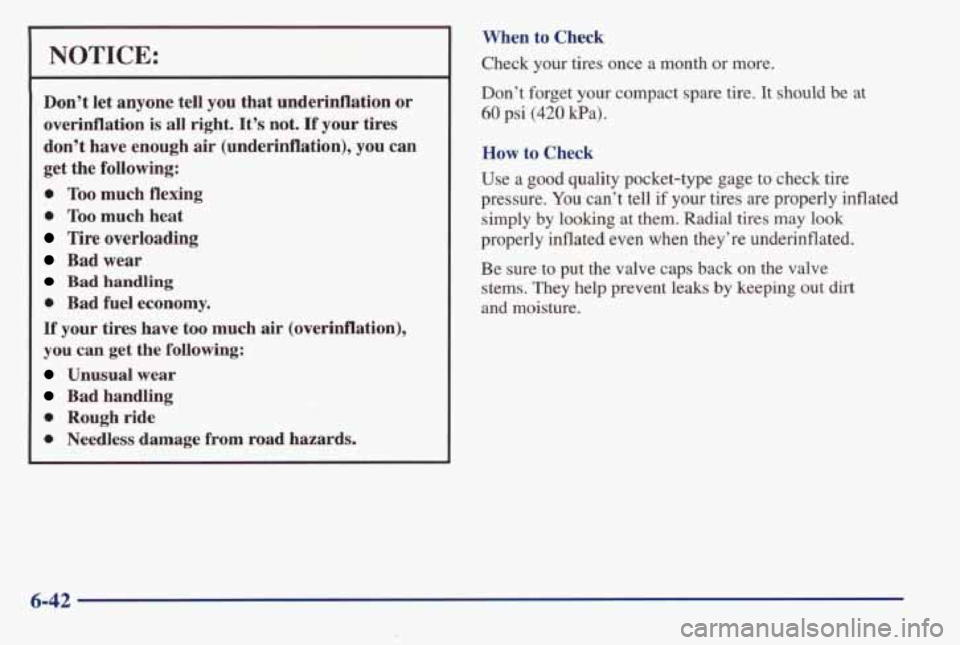
NOTICE:
Don’t let anyone tell you that underinflation or
overinflation is
all right. It’s not. If your tires
don’t have enough air (underinflation),
you can
get the following:
0 Too much flexing
0 Too much heat
Tire overloading
Bad wear
Bad handling
0 Bad fuel economy.
If your tires have too much air (overinflation),
you can get the following:
Unusual wear
Bad handling
0 Rough ride
0 Needless damage from road hazards. When
to Check
Check your tires once a month or more.
Don’t forget your compact spare tire. It should
be at
60 psi (420 Wa).
How to Check
Use a good quality pocket-type gage to check tire
pressure.
You can’t tell if your tires are properly inflated
simply by looking at them. Radial tires may look
properly inflated even when they’re underinflated.
Be sure to put the valve caps back on the valve
stems.
They help prevent leaks by keeping out dirt
and moisture.
6-42
Page 294 of 395
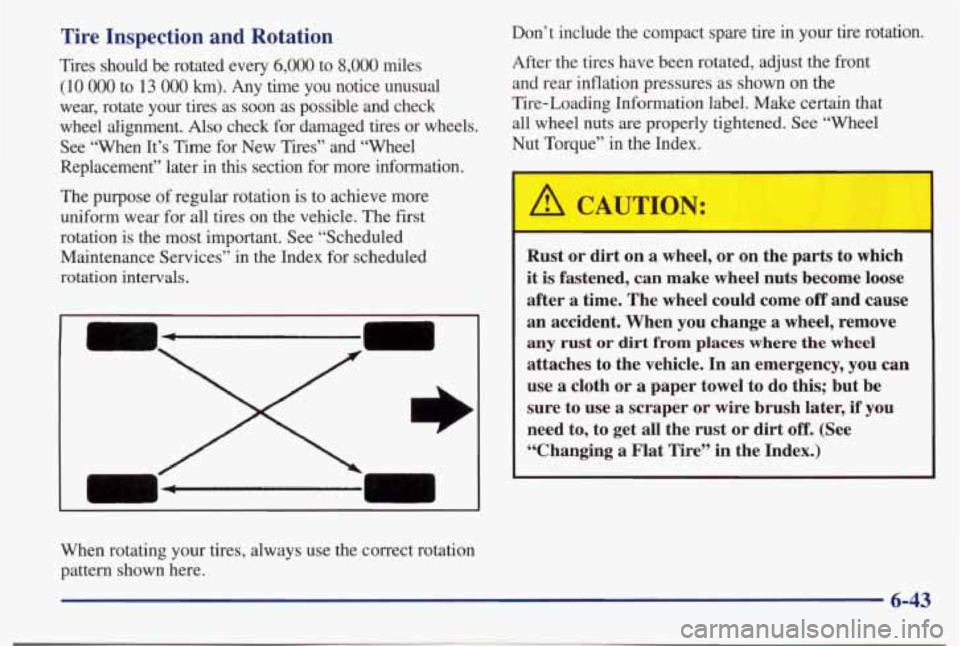
Tire Inspection and Rotation
Tires should be rotated every 6,000 to 8,000 miles
(10 OOO to 13 OOO km). Any time you notice unusual
wear, rotate your tires as soon as possible and check
wheel alignment.
Also check for damaged tires or wheels.
See “When It’s Time for New Tires” and “Wheel
Replacement” later in
this section for more information.
The purpose of regular rotation is to achieve more
uniform wear for all tires on the vehicle. The first
rotation is the most important. See “Scheduled Maintenance Services” in the Index for scheduled
rotation intervals.
m4
Don’t include the compact spare tire in your tire rotation.
After the tires have been rotated, adjust the front
and rear inflation pressures as shown
on the
Tire-Loading Information label. Make certain that all wheel nuts
are properly tightened. See “Wheel
Nut Torque” in the Index.
A CAUTION:
Rust or dirt on a wheel, or on the parts to which
it is fastened, can make wheel nuts become loose
after a time. The wheel could come
off and cause
an accident. When you change a wheel, remove
any rust or dirt from places where the wheel
attaches to the vehicle. In an emergency, you can
use a cloth or
a paper towel to do this; but be
sure to use a scraper or wire brush later,
if you
need to, to get all the rust or dirt
off. (See
“Changing a Flat Tire” in the Index.)
I
When rotating your tires, always use the correct rotation
pattern shown here.
6-43
Page 296 of 395
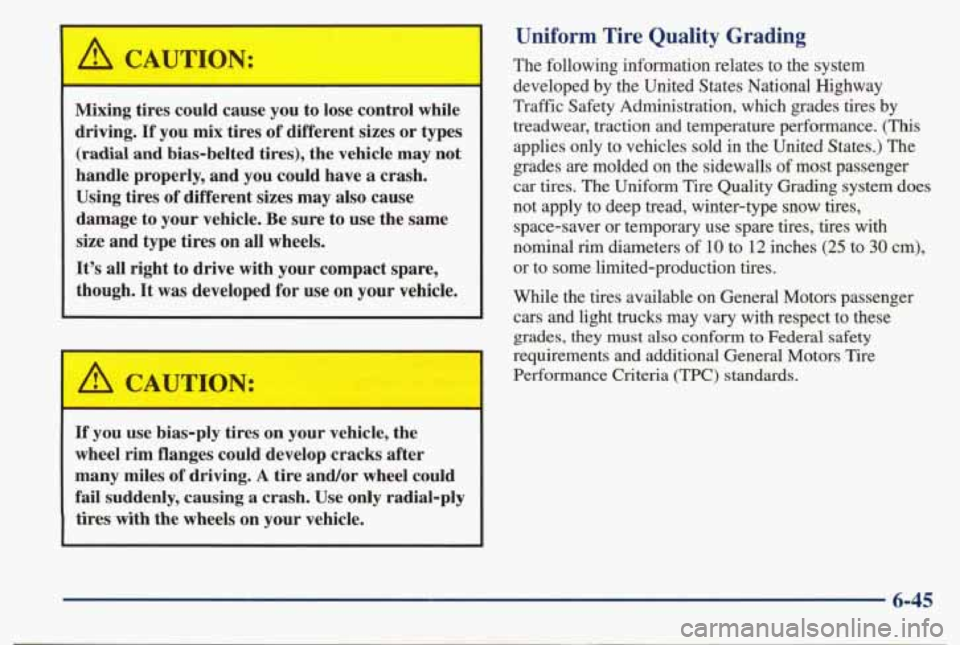
Mixing tires could cause you to lose control while
driving.
If you mix tires of different sizes or types
(radial and bias-belted tires), the vehicle may not
handle properly, and you could have
a crash.
Using tires
of different sizes may also cause
damage to your vehicle. Be sure to use the same
size and type tires on all wheels.
It’s all right to drive with your compact spare,
though.
It was developed for use on your vehicle.
I a CAUTION:
If you use bias-ply tires on your vehicle, the
wheel rim flanges could develop cracks after
many miles
of driving. A tire and/or wheel could
fail suddenly, causing a crash. Use only radial-ply
tires with the wheels on your vehicle.
Uniform Tire Quality Grading
The following information relates to the system
developed by the United States National Highway
Traffic Safety Administration, which grades tires by
treadwear, traction
and temperature performance. (This
applies only to vehicles sold
in the United States.) The
grades are molded on the sidewalls
of most passenger
car tires. The Uniform Tire Quality Grading system does
not apply to deep tread, winter-type snow tires, space-saver or temporary use spare tires, tires with
nominal
rim diameters of 10 to 12 inches (25 to 30 cm),
or to some limited-production tires.
While the tires available on General Motors passenger cars and light
trucks may vary with respect to these
grades, they
must also conform to Federal safety
requirements and additional General Motors Tire
Performance Criteria
(PC) standards.
6-45
Page 308 of 395
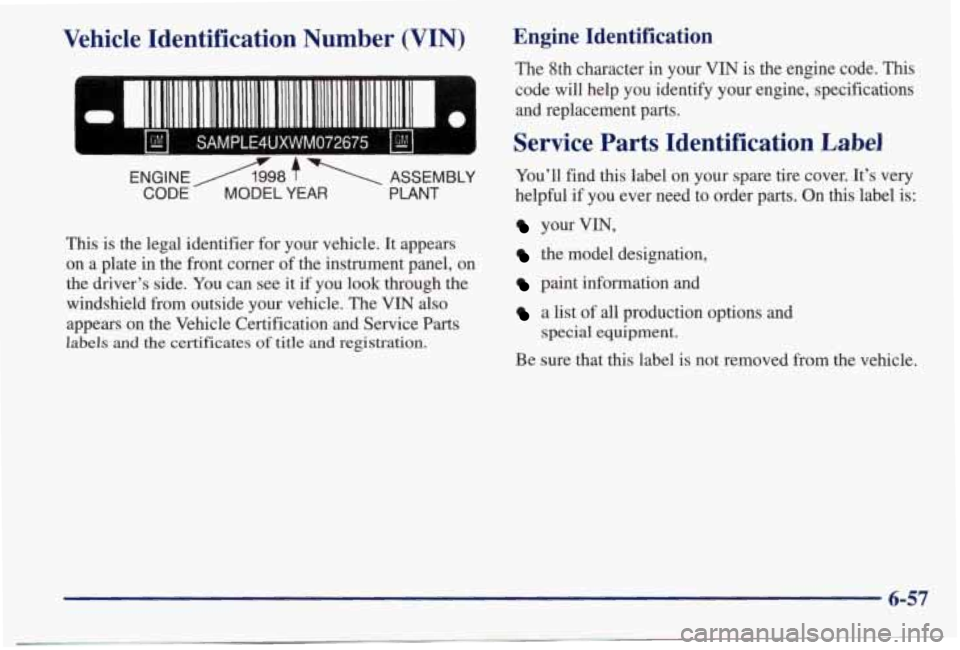
Vehicle Identification Number (VIN)
SAMPLE4UXWM072675 I
ENGINEA998 7 ASSEMBLY
CODE MODEL YEAR PLANT
This is the legal identifier for your vehicle. It appears
on a plate in the front corner of the instrument panel,
on
the driver’s side. You can see it if you look through the
windshield from outside your vehicle. The VIN also
appears on the Vehicle Certification and Service Parts
labels and the certificates of title and registration.
Engine Identification
The 8th character in your VIN is the engine code. This
code will help you identify your engine, specifications
and replacement parts.
Service Parts Identification Label
You’ll find this label on your spare tire cover. It’s very
helpful if you ever need to order parts. On this label is:
your VIN,
the model designation,
paint information and
a list of all production options and
special equipment.
Be sure that this label is not removed from the vehicle.
Page 376 of 395
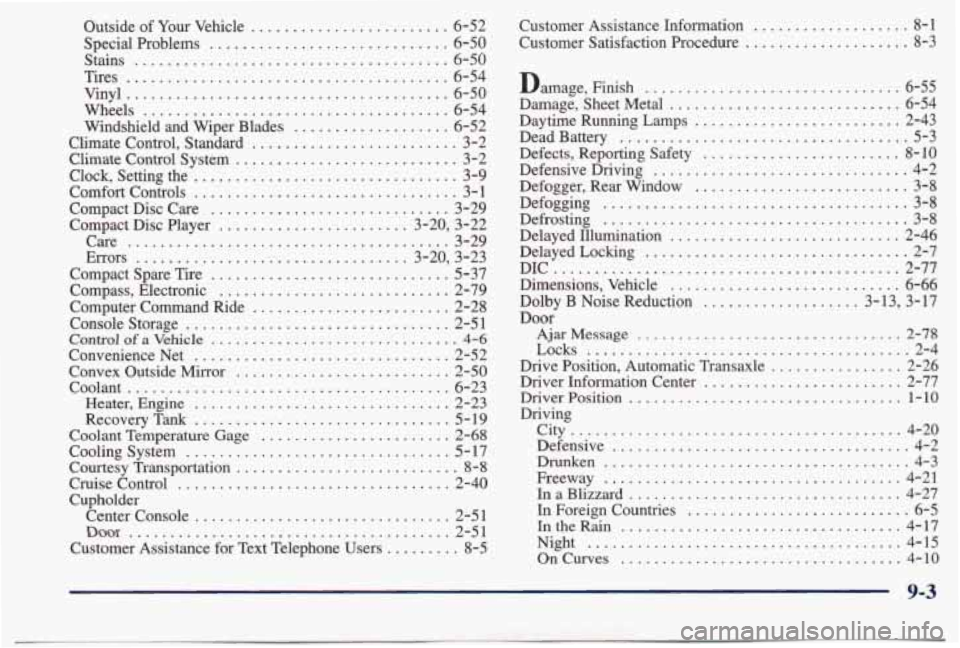
Outside of Your Vehicle ................ ... 6-52
Special Problems
............................. 6-50
Stains ...................................... 6-50
Tires
....................................... 6-54
Vinyl
....................................... 6-50
Wheels
..................................... 6-54
Windshield and Wiper Blades
................... 6-52
Climate Control. Standard
......................... 3-2
Climate Control System
........................... 3-2
Clock. Setting the
................................ 3-9
Comfortcontrols
................................ 3-1
Compact Disc Care
............................. 3-29
Compact Disc Player
....................... 3-20, 3-22
Care
....................................... 3-29
Errors
................................. 3-20. 3-23
Compact Spare Tire
............................. 5-37
Compass. Electronic
............................ 2-79
Computer Command Ride
........................ 2-28
Console Storage
................................ 2-5 1
Control of a Vehicle .............................. 4-6
Convenience Net ............................... 2-52
Convex Outside Mirror
.......................... 2-50
Coolant
....................................... 6-23
Heater. Engine
............................... 2-23
RecoveryTank
............................... 5- 19
Coolant Temperature Gage
....................... 2-68
CoolingSystem
................................ 5-17
Courtesy Transportation
........................... 8-8
CruiseControl ................................. 2-40
Cupholder Center Console
............................... 2-51
Customer Assistance for Text Telephone Users
......... 8-5
Door ....................................... 2-51 Customer Assistance Information
................... 8-1
Customer Satisfaction Procedure
.................. 8-3
Damage. Finish
............................... 6-55
Damage. Sheet Metal
............................ 6-54
Daytime Running Lamps
......................... 2-43
Dead Battery
................................... 5-3
Defects. Reporting Safety
........................ 8-10
Defensive Driving ............................... 4-2
Defogger. Rear Window
.......................... 3-8
Defogging
..................................... 3-8
Defrosting
..................................... 3-8
Delayed Illumination ............................ 2-46
Delayed Locking
................................ 2-7
DIC
.......................................... 2-77
Dimensions. Vehicle
............................ 6-66
Dolby
B Noise Reduction ................... 3-13. 3-17
Door
Ajar Message ................................ 2-78
Locks ....................................... 2-4
Drive Position. Automatic Transaxle
................ 2-26
Driver Information Center
........................ 2-77
DriverPosition
................................. 1-10
Driving
City
........................................ 4-20
Defensive
.................................... 4-2
Drunken
..................................... 4-3
Freeway
.................................... 4-21
InaBlizzard
................................. 4-27
In Foreign Countries
........................... 6-5
IntheRain
.................................. 4-17
OnCurves
.................................. 4-10
Night
...................................... 4-15
9-3
Page 383 of 395

Shoulder Belt Height Adjuster ..................... 1-12
Sidemarker Lamp Bulb Replacement
............... 6-35
Signaling Turns
................................ 2-37
Skidding ...................................... 4-14
Sound Equipment. Adding
........................ 3-28
Spare Tire. Compact
............................. 5-37
Specifications and Capacities
...................... 6-65
Specifications. Engine
........................... 6-66
Speech Impaired. Customer Assistance
............... 8-5
Speedometer ................................... 2-61
SRS ......................................... 1-18
Stains. Cleaning
................................ 6-50
Starter Switch Check
............................ 7-33
Starting
Your Engine ....................... 2-21. 2-22
Steam
........................................ 5-15
Steering
...................................... 4-10
In Emergencies
............................... 4- 1 1
Magnasteer
TM ................................ 4- 10
Power
...................................... 4-10
Tips
........................................ 4-10
Wheel. Tilt
.................................. 2-36
Wheel Touch Controls
......................... 3-26
Storage Compartments
........................... 2-5 1
Storage. Vehicle
................................ 6-32
Stuck:
In Sand. Mud. Ice or Snow .................. 5-38
Sun Visors .................................... 2-53
Sunglasses Storage
.............................. 2-5 1
Sunroof ....................................... 2-55
Supercharged Engine ............................ 6- 13
Supercharger Oil
............................... 6- 19
Symbols. Vehicle .................................. v
Supplemental Restraint System .................... 1 - 18 Tachometer
.................................. 2-62
Taillamp Bulb Replacement
....................... 6-37
Tape Player Care
............................... 3-28
Temperature Control. Climate Control System
..... 3.2. 3.3
Theater Dimming ............................... 2-47
Theft
......................................... 2-15
Theft-Deterrent
Alarm System .................... 2-16
Theft-Deterrent Feature. CD Player
................ 3-24
THEFTLOCK
TM ................................ 3-24
Thermostat
.................................... 6-26
Tilt Steering Wheel
............................. 2-36
Time. Setting
the ................................ 3-9
Tire Chains
.................................... 6-48
Tirehading
................................... 4-29
Tire-Loading Information Label
................... 4-29
Tires ......................................... 6-41
Alignment and Balance
........................ 6-47
Buying New
................................. 6-44
Chains ..................................... 6-48
Changing a Flat
.............................. 5-25
Cleaning .................................... 6-54
Compact Spare
............................... 5-37
Inflation
.................................... 6-41
Inflationcheck
............................... 7-31
Inspection and Rotation
........................ 6-43
Loading
.................................... 4-29
Pressure
..................................... 6-41
Temperature
................................. 6-46
Traction
.................................... 6-46
Treadwe
ar ................................... 6-46
Wear Indicators
.............................. 6-44
Wheel Replacement
........................... 6-47
When It’s Time for New
....................... 6-44
Uniform Quality Grading ....................... 6-45
9-10